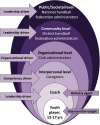Facilitators to support the implementation of injury prevention training in youth handball: A concept mapping approach
- PMID: 30339309
- PMCID: PMC7380009
- DOI: 10.1111/sms.13323
Facilitators to support the implementation of injury prevention training in youth handball: A concept mapping approach
Abstract
There is a need for research to identify effective implementation strategies for injury prevention training within real-world community sports. The aim of this ecological participatory study was to identify facilitators, among stakeholders at multiple levels, that could help injury prevention training become part of regular training routines in youth team handball. Concept mapping, a mixed-method approach for qualitative data collection and quantitative data analysis, was used. Stakeholders (n = 196) of two community team handball clubs (29% players, 13% coaches, 38% caregivers, 11% club, district and national handball administrators, 9% unknown) participated in a brainstorming process. After the research team synthesized the 235 generated statements, 50 stakeholders (34% players, 22% coaches, 24% caregivers, 20% administrators) sorted 89 unique facilitator statements into clusters and rated them for importance and feasibility. Multidimensional scaling and hierarchical cluster analysis yielded five clusters (stress value 0.231): "Understanding and applying knowledge," "Education, knowledge, and consistency," "Set-up and exercises," "Inspiration, motivation, and routines," and "Club policy and expert collaboration." The cluster "Understanding and applying knowledge" had the highest mean importance (3.17 out of 4) and feasibility (2.93) ratings. The 32 statements rated as both highly important and feasible (Go-zone) indicate action is required at the individual (end-users) and organizational (policymakers) levels to implement injury prevention training. Results suggest that developing evidence-based context-specific injury prevention training, incorporating physiological, biomechanical and psychological components, and an associated context-specific implementation plan in partnership with all stakeholders should be a high priority to facilitate the implementation of injury prevention training in youth team handball.
Keywords: adolescent; concept mapping; health plan implementation; preventive therapy; sports injuries; team ball sports.
© 2018 The Authors. Scandinavian Journal of Medicine & Science In Sports Published by John Wiley & Sons Ltd.
Figures




References
-
- Bergeron MF, Mountjoy M, Armstrong N, et al. International Olympic Committee consensus statement on youth athletic development. Br J Sports Med. 2015;49:843‐851. - PubMed
-
- Åman M, Forssblad M, Larsen K. Incidence and body location of reported acute sport injuries in seven sports using a national insurance database. Scand J Med Sci Sports. 2017;28:1147‐1158. - PubMed
-
- Olsen OE, Myklebust G, Engebretsen L, Bahr R. Injury pattern in youth team handball: a comparison of two prospective registration methods. Scand J Med Sci Sports. 2006;16:426‐432. - PubMed
-
- Soomro N, Sanders R, Hackett D, et al. The efficacy of injury prevention programs in adolescent team aports: a Meta‐analysis. Am J Sports Med. 2016;44:2415‐2424. - PubMed

